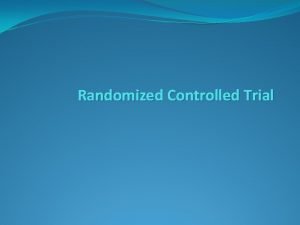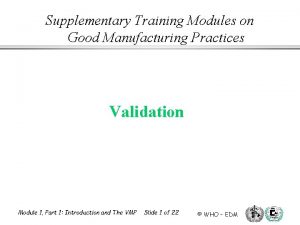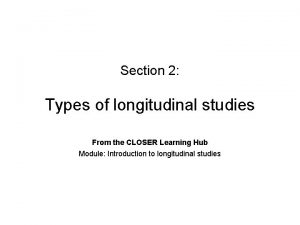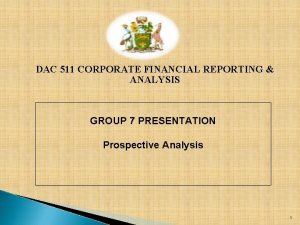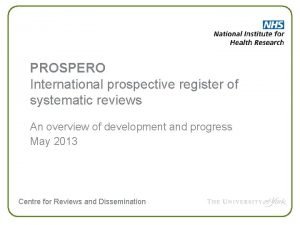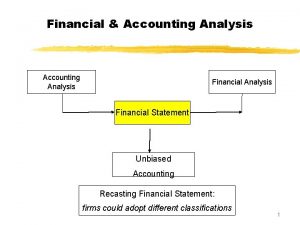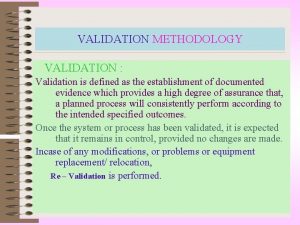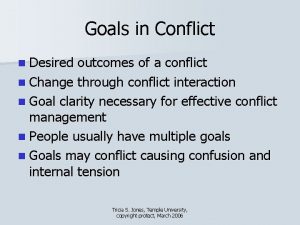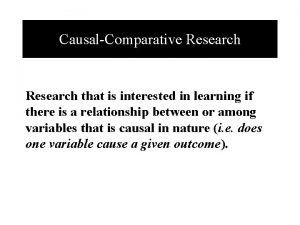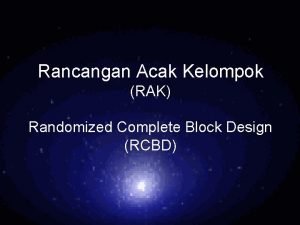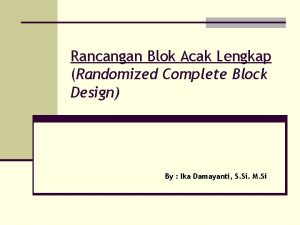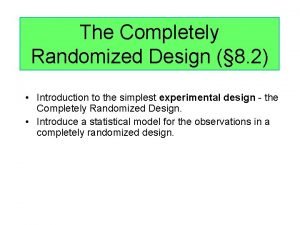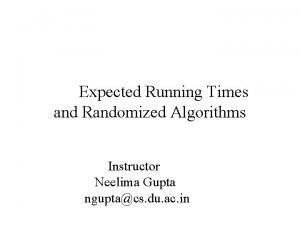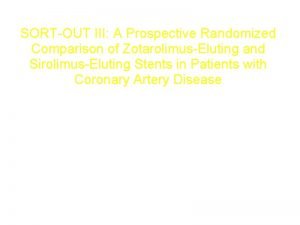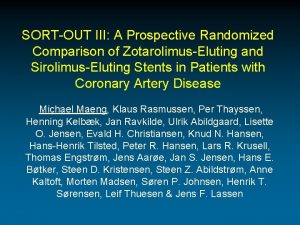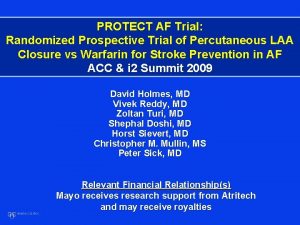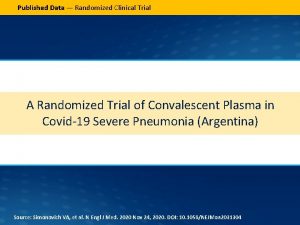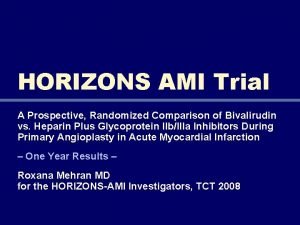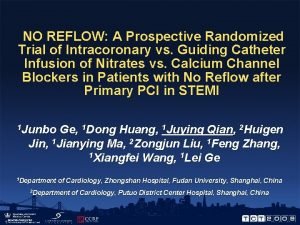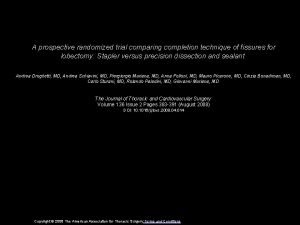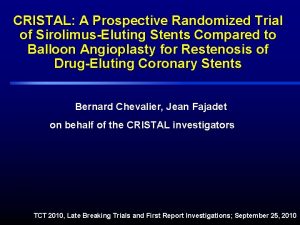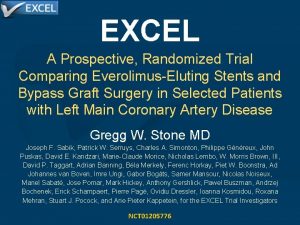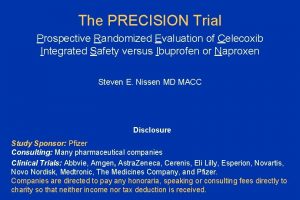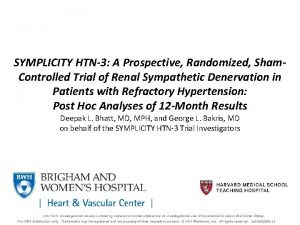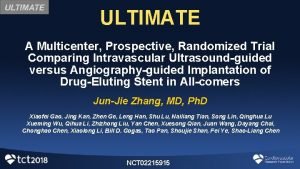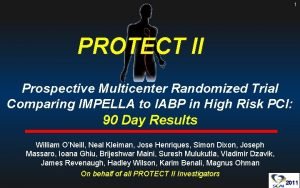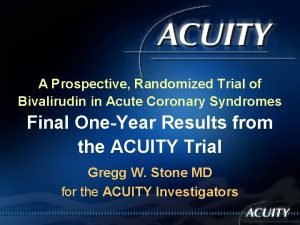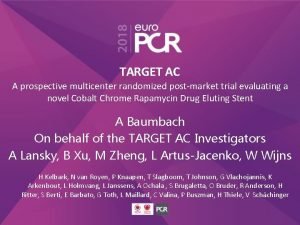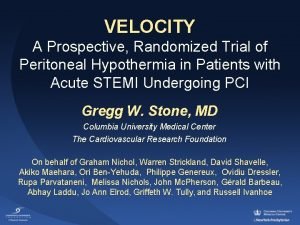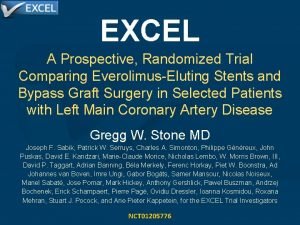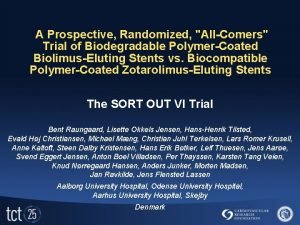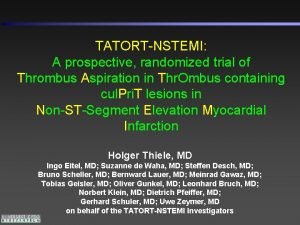SORTOUT VI A Prospective Randomized Trial of a

























- Slides: 25

SORT-OUT VI A Prospective Randomized Trial of a Durable. Polymer Zotarolimus-Eluting Stent Versus a Bioabsorbable-Polymer Biolimus-Eluting Stent in Patients With Coronary Artery Disease – Three-Year Outcomes Bent Raungaard, Evald Høj Christiansen, Svend Eggert Jensen, Michael Mæng, Christian Juhl Terkelsen, Lars Romer Krusell, Anne Kaltoft, Steen Dalby Kristensen, Hans Erik Bøtker, Leif Thuesen, Jens Aarøe, Hans-Henrik Tilsted, Anton Boel Villadsen, Per Thayssen, Karsten Tange Veien, Knud Nørregaard Hansen, Anders Junker, Morten Madsen, Jan Ravkilde, Jens Flensted Lassen, Lisette Okkels Jensen Aalborg University Hospital, Odense University Hospital, Aarhus University Hospital, Skejby Denmark

Disclosure Statement of Financial Interest I, Bent Raungaard DO NOT have a financial interest/arrangement or affiliation with one or more organizations that could be perceived as a real or apparent conflict of interest in the context of the subject of this presentation.

Background • Remnants of polymer materials on drug-eluting stents may trigger chronic inflammatory responses that can lead to impaired endothelialization of stent struts, malapposition, and increased risk of stent thrombosis. • In long-term randomized all-comer trials biodegradable-polymer biolimus-eluting stents have appeared to out-perform the first-generation durablepolymer drug-eluting stents.

Sort Out VI Objective To compare the safety and efficacy of the newgeneration durable-polymer zotarolimus-eluting Resolute Integrity stent with the biodegradablepolymer biolimus-eluting Bio. Matrix Flex stent in a population-based setting. Clinical. Trials. gov Identifier: NCT 01956448

Method • The trial was performed within the framework of the Scandinavian Organization for Randomized Trials with Clinical Outcome (SORT OUT). • The trial was designed to reflect daily clinical practice. Therefore, no control angiography or study related patient contact were scheduled. • We used patient driven clinical event detection, through data from Danish healthcare registries.

Primary Endpoint Major Adverse Cardiac Events at 12 months Composite of • cardiac death • myocardial infarction (not clearly attributable to a non-target lesion) • target lesion revascularization Presented at TCT 2013. Today: 3 -year follow-up.

Patient Population Enrollment period: March 2011 to August 2012 Criteria of inclusion • 18 years of age or older. • Chronic stable coronary artery disease or acute coronary syndromes. • At least one coronary lesion with more than 50% diameter stenosis in a vessel with a reference diameter of 2. 25 to 4. 0 mm. No restrictions were placed on number of treated lesions, treated vessels, or lesion length.

Patient Population Enrollment period: March 2011 to August 2012 Criteria of exclusion • Life expectancy less than one year. • Allergy to aspirin, clopidogrel, prasugrel, ticagrelor, zotarolimus, or biolimus. • Unacceptable risk by 12 -month dual antiplatelet treatment. • Inability to provide written informed consent.

Clinical Event Detection Randomization Event detection at follow-up Danish Civil Registration System National Patient Registry Western Denmark Heart Registry Death Cardiac Non-cardiac Hospital admission MI, UAP, SAP PCI and CABG Noncardiac TVR / TLR ISR Definite ST

Consort flow diagram Assessed for eligibility (n=7103) Excluded (n=1788) Eligible (n=5315) Not meeting inclusion criteria (n=1403) Enrolled in another study (n=385) Enrolled and randomized (n=2999) Eligible, not included (n=3245) Randomly assigned to ZOTAROLIMUS-ELUTING RESOLUTE INTEGRITY STENT (n =1502) Randomly assigned to BIOLIMUS-ELUTING BIOMATRIX FLEX STENT (n =1497) Lost to follow-up (emigration) (n=3) Lost to follow-up (emigration) (n=4) 3 -year clinical follow-up (n = 1499 patients) 3 -year clinical follow-up (n = 1493 patients) Index PCI Follow-Up Analysis

Patient Characteristics ZOTAROLIMUSELUTING STENT BIOLIMUSELUTING STENT 1502 1497 65. 7 ± 10. 7 65. 8 ± 10. 9 0. 66 Men (%) 76. 2 75. 8 0. 82 Diabetes (%) 17. 6 18. 0 0. 78 Hypertension (%) 59. 7 58. 1 0. 38 Lipid-lowering therapy (%) 59. 3 59. 1 0. 95 Current smoker (%) 30. 7 0. 97 Prior CABG (%) 8. 4 6. 8 0. 09 Prior PCI (%) 18. 7 22. 0 0. 03 Prior myocardial infarction (%) 18. 7 19. 7 0. 52 Body mass Index (kg/m 2) 26. 9 0. 97 No. of patients Age (years) p

Patient Characteristics No. of patients ZOTAROLIMUSELUTING STENT BIOLIMUSELUTING STENT 1502 1497 Indication for PCI (%) p 0. 11 Stable angina 45. 6 44. 8 NSTEMI / unstable angina 31. 0 33. 9 STEMI 19. 6 16. 9 Other 3. 8 4. 4

Lesion Characteristics No. of lesions ZOTAROLIMUSELUTING STENT BIOLIMUSELUTING STENT 1880 1791 Target vessel location (%) p 0. 72 Left main 0. 9 1. 2 Left anterior descending 40. 3 41. 5 Left circumflexus 23. 8 24. 0 Right coronary 33. 9 32. 3 Saphenous vein graft 1. 2 1. 0 56. 0 52. 7 0. 06 3. 2 (2. 9 - 3. 5) 3. 0 (2. 8 - 3. 5) 0. 10 Lesion type B 2/C (%) Reference vessel size (mm)

Procedural Characteristics ZOTAROLIMUSELUTING STENT BIOLIMUSELUTING STENT No. of lesions 1880 1791 Patients with > 1 lesion (%) 24. 7 21. 4 0. 04 Patients with > 1 stent (%) 35. 9 32. 6 0. 06 p Total stent length per patient (mm) 21. 0 (15. 0 - 30. 0) 18. 0 (14. 0 - 29. 0) <0. 01 Direct stenting (%) 0. 67 Maximum pressure (atm) 14. 9 15. 4 16. 0 (12. 0 - 18. 0) 0. 19 Stent delivery failure (%) 1. 7 2. 3 0. 29 Use of GP IIb/IIIa inhib. (%) 4. 8 5. 2 0. 60

1º Endpoint: Major Adverse Cardiac Events (cardiac death, myocardial infarction, target lesion revascularization) TCT 2013, 12 months ZES 5. 3% vs. BES 5. 1% Pnon-inferiority = 0. 006 Raungaard B et al. Lancet. 2015; 385(9977): 1527 -35

Major Adverse Cardiac Events, 3 Year (cardiac death, myocardial infarction, target lesion revascularization)

Major Adverse Cardiac Events, 3 Year (cardiac death, myocardial infarction, target lesion revascularization) OR=0. 90 95% CI (0. 71 -1. 14) P=0. 36 Biolimus 9. 6 % Zotarolimus 8. 6 %

Cardiac Death, 3 Year OR=0. 81 95% CI (0. 54 -1. 22) P=0. 31 Biolimus 3. 4 % Zotarolimus 2. 7 %

Myocardial Infarction, 3 Year (not clearly attributable to a non-target lesion) OR=1. 03 95% CI (0. 66 -1. 61) P=0. 89 Zotarolimus 2. 6 % Biolimus 2. 5 %

Target Lesion Revascularization, 3 Year OR=0. 98 95% CI (0. 72 -1. 33) P=0. 90 Biolimus 5. 5 % Zotarolimus 5. 4 %

Definite Stent Thrombosis, 3 Year OR=0. 89 95% CI (0. 44 -1. 77) P=0. 73 Biolimus 1. 1 % Zotarolimus 1. 0 %

Landmark Analysis Definite ST, 3 Year Zotarolimus 0. 6 % Biolimus 0. 7 % Zotarolimus 0. 4 % Biolimus 0. 4 %

Conclusion • The 3 -year results from the Sort-Out VI all-comer randomized trial show that both the durable-polymer zotarolimus-eluting Resolute Integrity stent and the biodegradable-polymer biolimus-eluting Bio. Matrix Flex stent have excellent long-term safety and efficacy profile.

Conclusion • At 3 -year follow up safety and efficacy measures including stent thrombosis were not significantly different between the durable-polymer zotarolimuseluting stent and the biodegradable-polymer biolimuseluting stent. • These data indicate that a durable polymer can be as safe and efficacious as a biodegradable polymer.

 Advantage of randomized controlled trial
Advantage of randomized controlled trial Longitudinal design
Longitudinal design Concurrent validation
Concurrent validation Longitudinal prospective study
Longitudinal prospective study Longitudinal prospective study
Longitudinal prospective study Sciglass database
Sciglass database Veille prospective
Veille prospective What is case series
What is case series Prospective memory psychology definition
Prospective memory psychology definition Iceberg phenomenon
Iceberg phenomenon Retrospective cohort study vs prospective cohort study
Retrospective cohort study vs prospective cohort study Prospective analysis financial statements
Prospective analysis financial statements Prospero register
Prospero register Institute for prospective technological studies
Institute for prospective technological studies Retrospective validation
Retrospective validation Operating roa
Operating roa Prospective memory examples
Prospective memory examples Concurrent validation
Concurrent validation Prospective goals definition
Prospective goals definition What is validation
What is validation Retrospective causal-comparative research
Retrospective causal-comparative research Rcbd adalah
Rcbd adalah Factorial randomized block design
Factorial randomized block design Completely randomized design
Completely randomized design Randomized polynomial time
Randomized polynomial time Expected running time of randomized algorithm
Expected running time of randomized algorithm
